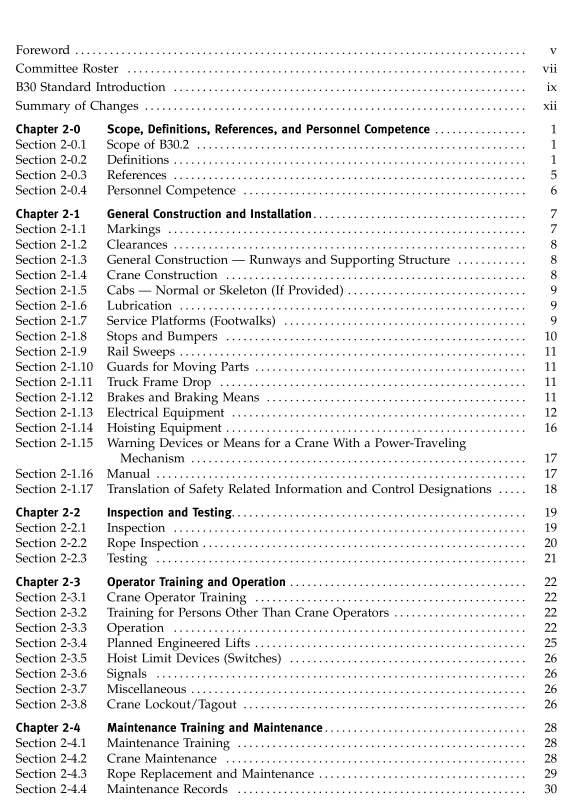ASME B30.2:2016 pdf download Overhead and Gantry Cranes (Top Running Bridge, Single or Multiple Girder, Top Running Trolley Hoist) Safety Standard for Cableways, Cranes, Derricks, Hoists, Hooks, Jacks, and Slings
depending on the properties of the flammable vapors,liquids,or gases,or combustible dusts or fibers thatmay be present and the likelihood that a flammable orcombustible concentration or quantity is present (seeNational Electrical Code,ANSI/NFPA 70).
hoist: a machinery unit that is used for lifting or loweringa freely suspended (unguided) load.
hoist mofion: motion that lifts or lowers a load.
hook,latch-equsipped: a type of hook with a mechanicaldevice to close the throat opening of the hook.
lifting devices: devices that are not reeved onto the hoistropes,such as hook-on buckets,magnets, grabs,andother supplemental devices used for ease of handlingcertain types of loads.The weight of these devices is tobe considered part of the rated load.
limit device: a device that is operated by some part ormotion of a power-driven hoist, trolley, or bridge to limitmotion.
loadd: the total superimposed weight on the load blockor hook.
load block: the assembly of hook or shackle, swivel, bear-ing, sheaves, pins, and frame suspended by the hoistingrope or load chain. This shall include any appurtenancesreeved in the hoisting ropes.
lockout/tagout: the placement of a lock / tag on the energy-isolating device in accordance with an establishedprocedure.
main hoist: the primary hoist mechanism provided forlifting and lowering the rated load.
minimen breaking force: the minimum load at which anew and unused wire rope will break when loaded todestruction in direct tension.
noncoasting mechanical drive: a drive that automaticallyresults in decelerating a trolley or bridge when poweris not available.
normal operafing conditions (of cab-operated cranes): condi-tions during which a crane is performing functionswithin the scope of the original design. Under theseconditions, the operator is at the operating controldevices, and there is no other person on the crane.ormal operating conditions (of floor-operated cranes): condi-tions during which a crane is performing functionswithin the scope of the original design. Under theseconditions, the operator is at the operating controldevices that are attached to the crane but operated withthe operator off the crane, and there is no person on thecrane.
normal operating condifions (of reofe-operated cranes): con-ditions during which a crane is performing functionswithin the scope of the original design. Under theseconditions, the operator is at the operating control
devices that are not attached to any part of the crane,and there is no person on the crane.
operational aid: an accessory that provides informationto facilitate operation of a crane or that takes control ofparticular functions without action of the operator whena limiting condition is sensed.Examples of such devicesinclude but are not limited to the following: upper andlower limit devices, travel limit devices, rated capacity(load) limiter, and wind speed indicator.
overload: any load greater than the rated load (seepara. 2-3.4).
parts of line: the number of lines of rope supporting theload block.
pendanf sfation: controls suspended from the crane foroperating the unit from the floor.
primary upper-linit device: the first device that,whenactuated , limits hoisting motion in the upward direction.qualified person: a person who. by possession of a recog-nized degree in an applicable field or a certificate ofprofessional standing, or who by extensive knowledge,training, and experience, has successfully demonstratedthe ability to solve or resolve problems relating to thesubject matter and work.
rail sveep: a device attached to the crane and located infront of the crane’s leading wheels to removeobstructions.
rated load (capacity): the maximum load designated bythe manufacturer for which a crane or individual hoistis designed and built.
rated speed: the maximum speed designated by the man-ufacturer for each motion (bridge, trolley, and hoist) forwhich a crane is designed and built.
reeving: a system in which a rope travels around drumsor sheaves.
rope: refers to wire rope unless otherwise specified.r1LJay: an assembly of rails, beams. girders, brackets,and framework on which the crane travels.
service platform: a means provided for workers to performmaintenance, inspections, adjustments,and repairs ofcranes.
shall: a word indicating a requirement.
sheave: a grooved wheel or pulley used with a rope tochange direction and point of application of a pullingforce.
sheazve ,11ONrerning (equalizer): a sheave used to equalizetension in opposite parts of the rope.Because of its slightmovement, it is not termed a running sheave.
sheave, ruring: a sheave that rotates as the load blockis lifted or lowered.
should: a word indicating a recommendation.
ASME B30.2:2016 pdf download
